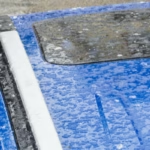Hailstorms can wreak havoc on your vehicle, leaving behind dents, broken windows, and other damage. If your car has been affected by hail, filing an insurance claim can help cover the repair costs. However, navigating the claims process can be confusing if you’re not familiar with it. In this article, we’ll walk you through the steps to file a hail damage car insurance claim, what to expect, and tips to ensure a smooth process.
Step 1: Assess the Damage
Before filing a claim, inspect your car thoroughly to assess the extent of the hail damage.
- Check for Dents: Look for dents on the roof, hood, trunk, and doors.
- Inspect Windows: Check for cracks or shattered glass.
- Document the Damage: Take clear photos and videos of all damage from multiple angles.
Step 2: Review Your Insurance Policy
Not all insurance policies cover hail damage, so it’s essential to review your policy details.
- Comprehensive Coverage: Hail damage is typically covered under comprehensive insurance, which protects against non-collision incidents like weather, theft, and vandalism.
- Deductible: Check your deductible amount, as you’ll need to pay this before your insurance covers the rest.
- Coverage Limits: Ensure your policy covers the full cost of repairs or replacement.
Step 3: Contact Your Insurance Company
Once you’ve assessed the damage and reviewed your policy, contact your insurance provider to start the claims process.
- Report the Damage: Provide details about the hail damage, including when and where it occurred.
- File the Claim: Most insurers allow you to file a claim online, via their app, or over the phone.
- Claim Number: Obtain a claim number for reference during the process.
Step 4: Schedule an Inspection
Your insurance company will likely send an adjuster to inspect the damage and estimate repair costs.
- Prepare Your Car: Clean your car and remove any personal items to make the inspection easier.
- Provide Documentation: Share the photos and videos you took of the damage.
- Ask Questions: Discuss the adjuster’s findings and ask about the estimated repair timeline.
Step 5: Get Repair Estimates
While the insurance adjuster will provide an estimate, it’s a good idea to get quotes from reputable auto repair shops.
- Compare Quotes: Ensure the repair costs align with the adjuster’s estimate.
- Choose a Shop: Select a repair shop that works with your insurance company or is approved by them.
Step 6: Approve the Claim
Once the inspection and estimates are complete, your insurance company will finalize the claim.
- Review the Offer: Ensure the settlement covers all necessary repairs.
- Negotiate if Needed: If the offer seems low, provide additional evidence or request a re-inspection.
- Accept the Settlement: Once satisfied, approve the claim to receive payment.
Step 7: Repair Your Car
With the claim approved, you can proceed with repairs.
- Pay the Deductible: You’ll need to pay your deductible before the insurance covers the remaining costs.
- Monitor Repairs: Stay in touch with the repair shop to ensure the work is completed to your satisfaction.
Tips for a Smooth Hail Damage Insurance Claim
- Act Quickly: File your claim as soon as possible to avoid delays.
- Keep Records: Save all receipts, estimates, and communication with your insurer.
- Be Honest: Provide accurate information to avoid claim denial or delays.
- Understand Your Policy: Know what’s covered and what’s not to avoid surprises.
What If Your Claim Is Denied?
If your hail damage claim is denied, you have options:
- Review the Reason: Understand why the claim was denied and gather additional evidence if needed.
- Appeal the Decision: Submit an appeal with supporting documentation.
- Seek Legal Advice: Consult an attorney if you believe the denial was unfair.
Conclusion
Filing a hail damage car insurance claim doesn’t have to be stressful. By following these steps and staying organized, you can ensure a smooth process and get your car back in top condition. Remember, comprehensive coverage is key to protecting your vehicle from unexpected weather events like hailstorms.







